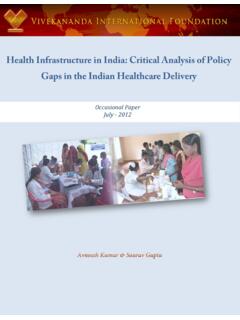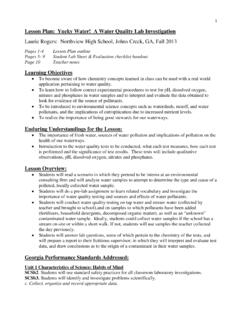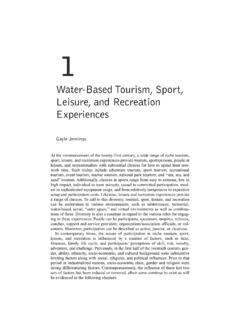Transcription of River Water Pollution - A New Threat to India: A Case ...
1 River Water Pollution - A New Threat to India: A Case Study of River Ganga1 The paper is the author s individual scholastic articulation. The author certifies that the article/paper is original in content, unpublished and it has not been submitted for publication/web upload elsewhere, and that the facts and figures quoted are duly referenced, as needed, and are believed to be correct. Vivekananda International Foundation 2019 Published in October 2019 byVivekananda International Foundation3, San Martin Marg | Chanakyapuri | New Delhi - 110021 Tel: 011-24121764 | Fax: 011-66173415 E-mail: us on Twitter | @vifindia Facebook | /vifindiaAll Rights part of this publication may be reproduced, stored in a retrieval system, or transmitted in any form, or by any means electronic, mechanical, photocopying, recording or otherwise without the prior permission of the The Author Major General (Retd.)
2 Ajay Kumar Chaturvedi, AVSM, VSM has been a Sapper officer, who post his retirement has been working on issues related to Non-traditional threats to National Security and Disaster management. He has written extensively on Water security and energy security and disaster management strategies. IntroductionWater is absolutely essential for the basic sustenance of human being. No wonder most of the civili-sations have come up on the banks of rivers or in the River valleys. India is no exception. In India every city has come up on the bank of a major River . Here it needs to be noted that fresh Water is finite. Total Water available in the world is 1,400,000 cubic km. However percent of it is there in the oceans and only percent is ground Water , percent is in glaciers and.
3 01 percent is in the atmosphere in the form of Water percent is fresh Water and percent of this fresh Water is in the form of ice and only percent is in the lakes and rivers. Finally, percent of the fresh Water is within biological 70 percent of the fresh Water is used up for the agriculture and with the changing crop pattern the requirement of the freshwater is on the rise. To make matters worse, the population is also expo-nentially rising. As per the Food and Agriculture Organization (FAO) estimates the Water usage has been growing at more than twice the rate of population increase in the last Pollution is making matters worse. In case of the Indian Sub-continent, 30 percent of the major Himalayan rivers are biologically dead for fishing and usage for human consumption.
4 Rising population is another factor which is affecting the per capita Water availability. In this connection it is pertinent to note that in 1951 Water availability in India was 5177 cubic metres per capita per year, which had got reduced to 1342 Cubic metres per person per year by 2000. With rise in popu-lation since year 2000 it must have become Shortage of Water and its centrality is going to cause major social and geopolitical stresses. Our neighbours like Pakistan, China and Bangladesh are having their own problems due to Water scarcity. Since Water resources of Indian Sub-continent are monolithic in nature, the shortage has its own international ramifications. Therefore, there is a need to address the Water issues on priority. In India, one of the most important River is Ganga which is the lifeline of a major portion of the population of the Northern India.
5 Decline in its quality of Water is affecting the health, agriculture and overall life style of a major portion of the Indian masses. A detailed study to analyse the prob-lems of Ganga will be quite useful and revealing to understand the problems related to the River waters in Water Pollution - A New Threat to India: A Case Study of River Ganga1. The entire data has been taken from the book, Water a Source of Future conflicts by Maj Gen AK Chaturvedi, Pub by Vij Books India Pvt Ltd, New Delhi during 2013. 2. Jayshree Nandi, Poison in our Paani , pub in the Times of India , New Delhi addition, dated 02 Dec 2012, Water Pollution - A New Threat to India: A Case Study of River Ganga5 Case Study of the River Ganga River Ganga is not a normal River , it is not only the life line of Northern India but also has a very spe-cial place in the spiritual consciousness of every Hindu irrespective of the fact whether that person in based in India or is a Person of Indian Origin (PIO) settled abroad.
6 The 2,525 km River rises in the western Himalayas in the Indian State of Uttarakhand and flows south and east through the Gan-getic plains of India and Bangladesh, eventually emptying into the Bay of Bengal. Enroute a large number of rivers and streams join it to make it a mighty River . The Ganga is a lifeline to 40 percent population of India who live along its course. By discharge, it is the fifth largest River in the World:-Table-1: Five Largest Rivers of the World by DischargeSource: Maj gen AK Chaturvedi, Water a Source of Future Conflicts , Page 4 River Ganges is considered a sacred River by Hindus, and worshiped as the goddess Ganga in Hindu pantheon. It has been important historically: many former provincial or imperial capitals (such as Pataliputra, Kannauj, Kara, Kashi, Prayagraj, Murshidabad, Munger, Bahrampur, Kampilya and Kolkata) have all been located on its banks.
7 Map-1: Course of Ganges and its Major TributariesSource: Water Pollution - A New Threat to India: A Case Study of River Ganga6 The Course of the River from Sky to OceanAfter originating from the Gangotri Glacier at Goumukh in Garhwal Himalayas in Uttarakhand as the River Bhagirathi, the main stream of the River Ganga begins at the confluence of the Bhagirathi and Alaknanda rivers in the town of Devaprayag of the Indian State of Uttarakhand. The headwa-ters of the River Alaknanda are formed by snowmelt from peaks such as Nanda Devi, Trishul and Kamet. Although many small streams contribute to the headwaters of the Ganga, six longest and their five confluences are considered sacred and important. The six headstreams are: Alaknanda, Dhauli-ganga, Nandakini, Pindar, Mandakini and Bhagirathi.
8 The five confluences, known as the Panch Prayag, are all along the Alaknanda. From up to downstream order, they are: Vishnuprayag; where the Dhauliganga joins the Alaknanda; Nandprayag, where the Nandakini joins; Karnaprayag, where the Pindar joins, Rudraprayag, where the Mandakini joins; and finally, Devprayag, where the Bha-girathi joins the Alaknanda to form the Ganga. After flowing 250 km through mountains, Ganga finally emerges in the plains at Rishikesh. At Haridwar, it is dammed at Bheemgoda Dam, from where some of its Water gets diverted into the Ganga Canal, whereas the River , whose course has been roughly southwest until this point, now begins to flow southeast through the plains of northern India. The Ganga River follows an 800 km course passing through the cities of Kannauj, Farrukhabad and Kanpur.
9 Along the way it is joined by the River Ramganga near Kannauj. Ganga is joined by the River Yamuna at Prayagraj. At their confluence at Prayagraj, the Yamuna is larger than the Ganga, contributing about percent of the combined flow. Now flowing east, Ganga River meets the Tons River (ancient name Tamsa) at Sirsa, about 311 km downstream of Prayagraj. After the Tons, the Gomti River joins Ganga near Saidpur, Kaithi in Varanasi district. Then the Ghaghra River , also flowing south from the Himalayas of Nepal, joins. The largest tributary of the Ganges, it is known as Karnali in Nepal. Next important River to join is the Son River . It is the principal southern tributary of the Ganga River , which rises in the state of Madhya Pradesh. It flows north past Manpur and then turns north-east.
10 The River joins the Ganga above Patna. The Gandaki River and the Kosi River from Nepal also join Ganga with massive inflow. In fact, Kosi is the third largest tributary of the Ganga, after Gh-aghara and Yamuna. Kosi River merges into Ganga near Kursela in Bihar. Along the way between Prayagraj in Uttar Pradesh and Malda in West Bengal, the Ganga River passes through the towns of Chunar, Mirzapur, Varanasi, Ghazipur, Ballin, Buxar, Chapra, Hajipur, Patna, Bhagalpur and many others. At Bhagalpur, the River begins to flow South-Southeast and at Pakur, it begins its attrition with the branching away of its first distributary, the Bhagirathi-Hooghly which goes on to become the Hooghly River . Just before the border with Bangladesh, the Farakka Barrage controls the flow of Ganga, diverting some of the Water into a feeder canal linked to the Hooghly for the purpose of keeping it relatively silt-free.








